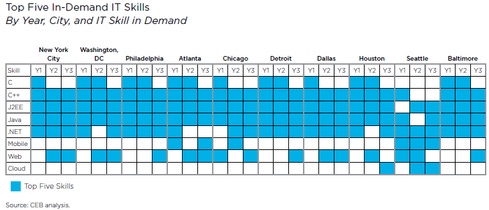IT jobs in the tech sector will stall while non-tech industries will drive IT job growth, impacting job geography and skills, says new report.


9 Job Hunt Tips For Older IT Pros
9 Job Hunt Tips For Older IT Pros (Click image for larger view and slideshow.)
IT job creation within the technology sector will stall or decline through 2018, with non-tech industries such as manufacturing, automotive, healthcare, and retail driving IT job growth instead, according to a new report from advisory company CEB.
This shift will create increased competition for IT talent and a new IT job skillset, and will force organizations to think beyond traditional talent pools and candidate profiles to attract and retain the best employees.
The IT sector employs only about one-third of the total IT workforce, while non-IT industries employ the remaining two-thirds of private sector IT workers, according to the report, which analyzed more than 900 cities and 1,000 skills.

[How does your job stack up? Read IT Salaries: 8 Cold Hard Facts.]
As IT sector employment stalls as a percentage of the total US IT workforce, non-IT sectors will expand: The manufacturing and automotive industries are forecasted to most aggressively grow the share of the workforce, followed by healthcare, retail, and aerospace and defense, the report said, leading to a greater geographic diversity of jobs.
Last year, 67% of IT workers in the US were concentrated in 10 states. But untraditional talent hubs for the IT workforce are emerging, based on their high demand for workers. Pennsylvania, Georgia, Illinois, and Texas ranked in the top seven states with the most IT job openings, according to the report.
"As technology-enabled products and services become more important to the innovation agenda of companies not traditionally defined as IT companies, both the demand and the supply of IT talent is growing beyond historical state and city IT talent hubs such as San Francisco or Seattle," the report said.
Lower costs and availability of skilled talent have made Philadelphia, Oklahoma City, Charlotte, Chicago, Houston, and Atlanta popular locations. Last year, the number of open jobs as a percentage of the total IT workforce was at or above 30% in Philadelphia and Oklahoma City, for example, while the San Francisco Bay area and New York were at about 12%, the report said.
"The good news is that individuals looking for jobs may be able to find tech jobs much closer to home since they don't need to move to Washington D.C., Texas, or California," said Jean Martin, executive director at CEB, in an interview. "The bad news is that the demand for skills is shifting toward more complex tech positions, which means baseline tech skills are commoditizing and they need to take their skills to the next level to do these jobs."
According to the report, the top five skills in demand by city highlight a considerable shift from traditional skills such as C and C++ to Web, .NET, and mobile skills. Six new emerging roles include technology brokers, cloud integration specialists, collaboration evangelists, service architects, user experience designers, and information insight enablers, according to CEB.

Given the growth of IT jobs in non-IT sectors, this shift is natural, Martin said.
"Industries like hospitality, retail, and manufacturing aren't interested in C++, they're interested in who can manage an IT-enabled customer interface," she pointed out. "It's the liberal arts of technology jobs -- we're seeing companies start to bring in hard tech skills with broader business-based and customer management skills."
As a result, job seekers will need to expand their skill set in order to stay relevant and desirable. "In order to compete for jobs, people will have to go much farther to differentiate themselves," Martin noted. "They will need to be customer experience experts or data experts to do these much more creative jobs on the tech side. We're going to see a different education and career path in the future."
Cyber-criminals wielding APTs have plenty of innovative techniques to evade network and endpoint defenses. It's scary stuff, and ignorance is definitely not bliss. How to fight back? Think security that's distributed, stratified, and adaptive. Get the Advanced Attacks Demand New Defenses report today. (Free registration required.)
About the Author(s)
You May Also Like







